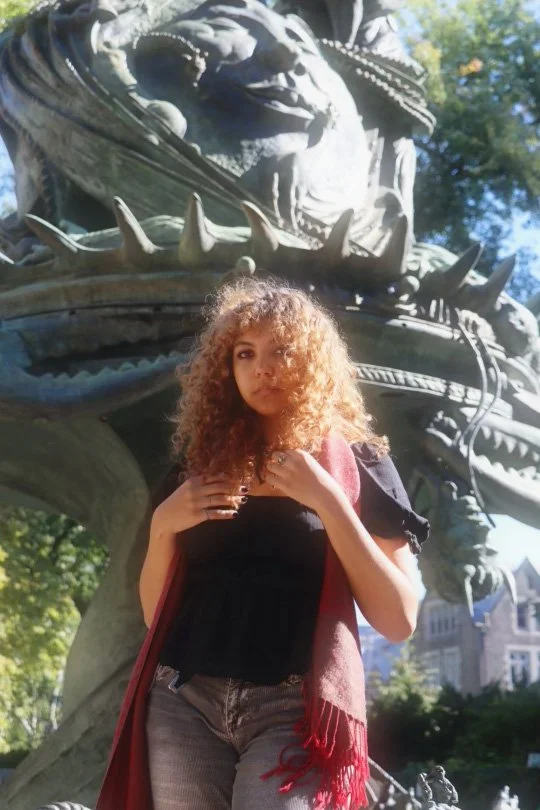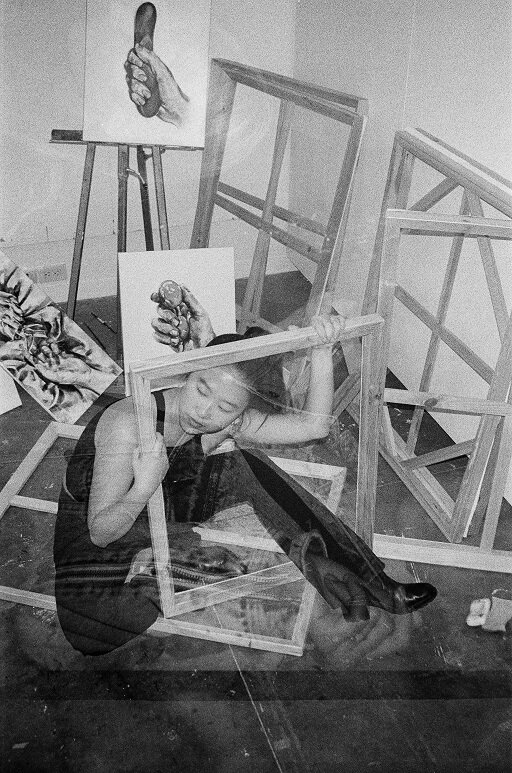
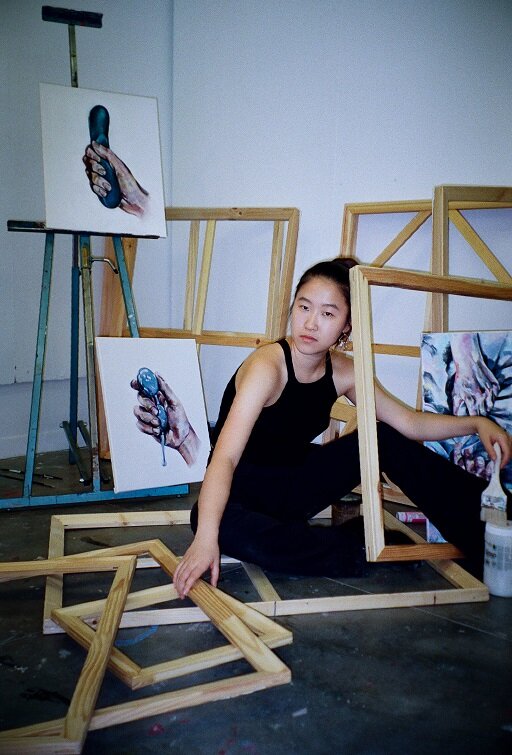
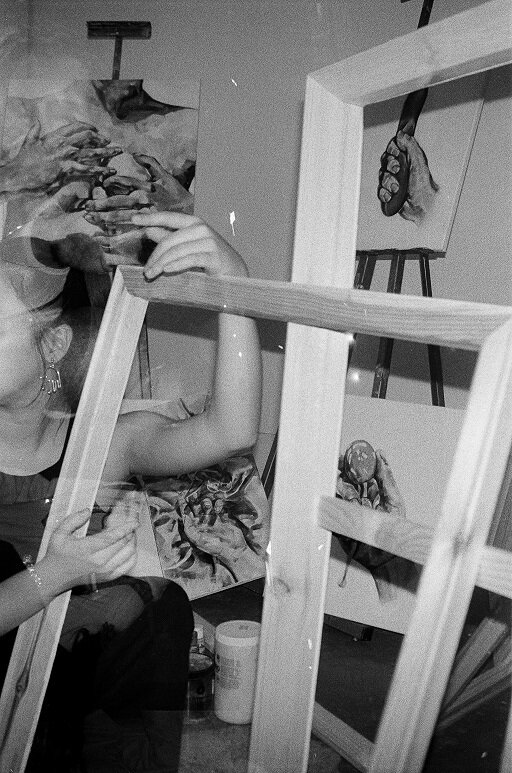
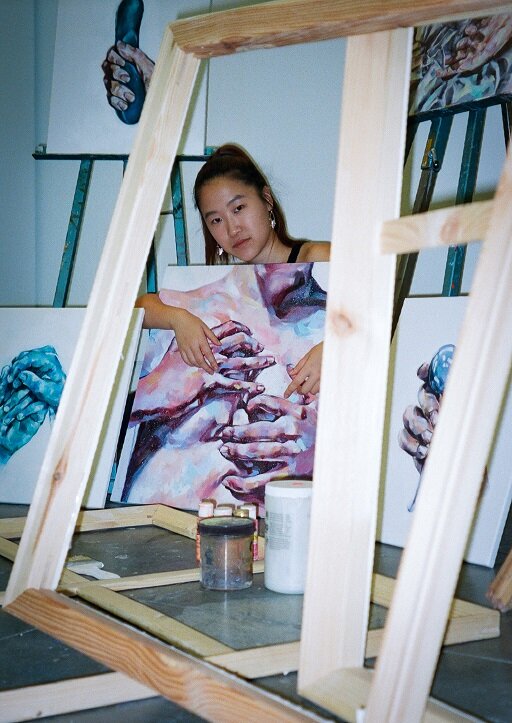
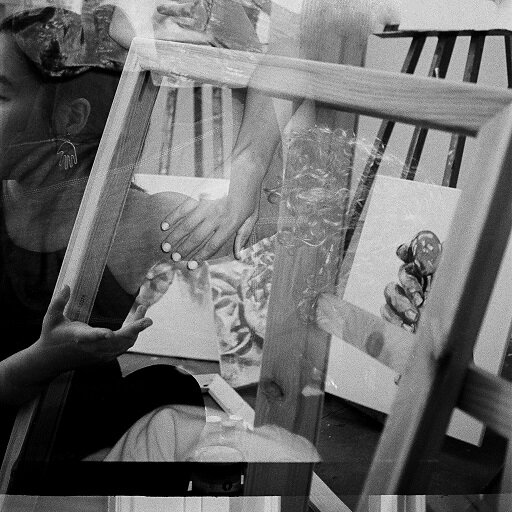
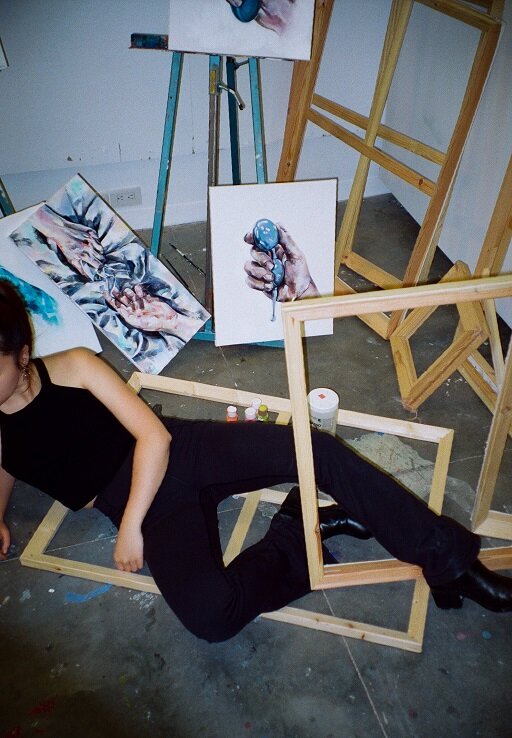
Photographs by Margaret Maguire
In Conversation with Morgan Becker
Could you introduce yourself?
My name is Xixi Wang, I’m a sophomore at Barnard College. I do acrylic paintings and graphite drawings on the side sometimes. I was raised in Vancouver, Canada, and for the majority of my life I was really focused on music. I was a competitive pianist for a really long time, so when I moved to New York five years ago, that was when I really started honing in on my artwork. I always loved drawing—painting not so much (laughs). But when I got to New York, that’s when I really found my love for it and put my music to the side. During the era of Instagram, my friends started suggesting that I post my stuff online. That’s where my art career began—I just drew whatever I wanted. I mainly started off with, like, celebrity portraits and Disney caricatures, and I would just post everything that I drew on Instagram. And slowly, my following started to build. Here we are today.
Would you say that your music has an influence on the work that you do? Or was a clean break from one form of art to the other?
I felt like it was more of a break-off. Because music was really something that my parents pushed me to pursue, and art was more of a side thing. I really liked art classes at school, but other than that, it was music all the time. People at school knew me as the musician, the pianist, who spends all her time doing that. And then when I moved to New York—it was also at a point where I couldn’t really do anything else with music. I could pursue it professionally, or not. So I kind of just dropped it—or it at least became a less important part of my life. I still love music to this day.
Did music ever feel creative to you?
I don’t think so. No, because I was so classically trained. A lot of it was, like, taking examinations—in Canada, you have Royal Conservatory examinations. So a lot of it was taking exams until you reach a certain level. I did take composition classes and music history classes, but it never got to a point at which I felt like I had creative freedom over my music.
From what I see from your work, you do a lot of painting of bodies—literally and figuratively. Where does the fascination come from?
This is a fascination that has evolved very recently. As I mentioned before, my past artwork was a lot of pop-culture stuff. That was when I mostly considered myself a ‘drawer.’ When I dove into painting, that’s when I created my own sense of style as an artist. I just kind of paint subject matter that I gravitate toward. I never force myself to branch out, or paint something that I don’t speak with. So, why bodies? Now that I’m thinking about it, I don’t really know why. For a long time I loved painting pieces that made you think, and that made you feel something. A lot of the issues that I’m passionate about concern gender, or sexuality. I think that I reflect that through the work I create.
In what ways do you think femininity is shown through the body?
I mean, there are ways that we dress ourselves—but that’s unrelated to the pieces that I create. I do more bare bodies, and minimalistic stuff. So in terms of my pieces specifically, I try to strip away gender. My models are usually female. I haven’t really painted male bodies or faces. But I feel like my style is very feminine, if that makes sense? A lot of the colors that I use are pastel, and the way that I work my paint—there’s an elegant texture to it, but it’s also a bit rough. I don’t know, I feel like the feminine aspect for me is more the style of the work, rather than the body being portrayed on the canvas.
I notice that a lot of the work is also segmented. You never paint a full portrait. Is there a reason for that?
I love zooming in, close-ups in general. It’s a very intimate way to showcase a woman’s body. And it also provides mystery, and gives me more of a sense of creative freedom. I paint however I want to paint, if that makes sense? If you’re painting a model, their entire body, proportions are really important. Making it look like the actual figure is really important. Which is kind of why I stray from portraits. It gets too much into, ‘Oh, who are you painting?’ ‘Why did you choose this model?’ et cetera. So I tend to zoom into parts of the body where you don’t necessarily know who the person is, and you don’t have that necessity to compare.
What does touch mean to you?
Exploring touch has been a fairly recent thing of mine, but I love painting hands. It’s something that I’ve had an obsession with for a long time. I know for many artists, it’s a pain in the ass. But it’s actually one of my favorite things to paint. And through all of the pieces of hands that I’ve created, I feel like there’s a similar theme centered around human relationships. Touch has a lot to do with that. I mentioned this in my artist bio, but I think that touch—out of all the five senses—is the most interesting. It has the most layers to it. It’s so complex. But overall, the main reason why—this is going to sound cheesy, but it connects the mind and the heart in a way that sounds, or smells, can’t do. There’s a very emotional side to touch, as well as physical. It’s a fundamental sense that connects us together as human beings. Imagine never hugging someone, and losing that sense of comfort. I think touch encompasses so many emotions that I like to reflect through painting. At the end of the day, my painting aren’t just hands. They reflect a deeper sense of emotional value and make you think about what the hands are doing, and how they’re interacting with each other to make you feel a certain way.
Do you think touch is inherently intimate?
I think there’s definitely an intimate aspect to it. I don’t think it’s inherent—it’s intimate if you want it to be intimate. But in my pieces specifically, I try to find that intimate level. Like, I really do want that intimacy between the viewer and the painting itself.
Do you tend to base those painting off your own relationships? Models? What do you use for reference?
I do some of both. A lot of it is Google searching, and finding non-copyrighted material. A lot of it uses my own body as a reference. Especially for hands, that’s definitely easier. I’ll just take photos of them from different angles, changing the lighting as I go. Also, there is an app where you can take a hand model and basically rotate it however you want, but it isn’t the most realistic. So I just tend to take my own reference images—if for some reason I can’t, I’ll just go off of Google.
Tell me about your work with temporary tattoos, and how it came about.
So I work with this company called Inkbox, and they do semi-permanent tattoos. They last from eight to eighteen day. They’re from a fruit-based ink, very similar to henna but completely different ingredients. I design a lot of the tattoos on their website, and I also do freehand, which is where you work with a bottle of ink and apply the tattoo similarly to henna. Wherever you’re getting the tattoo, it’ll take 24 hours to fully develop, and it’ll stay for roughly two to three weeks.
How I got into it is kind of a long story. Ever since I was a teenager I was really into tattooing—not getting tattoos myself, but the industry in general, and tattooing as an art form. Tattoo artists are so talented, to be able to create these gorgeous pieces of artwork on someone’s body, using the human as a canvas. Having their art carried around forever. So I’d always told myself that I wanted to learn how to tattoo. Someday! But that hasn’t happened yet. I’m still crossing my fingers. I found out about Inkbox roughly three years ago. They had just launched a kickstarter and completely blew up. I started as one of their purchasers, just trying their products. I thought they were really cool as a company, and as a general concept. And then, maybe a year into it, they were looking for artists to design tattoos. I applied, got the position, and ever since then I’ve been in contact with their team. They know that I live in New York, so whenever they have pop-up events they’ll shoot me a text and ask if I can work for them.
It’s interesting that you said tattoos are a form of art that are carried around forever. I get that they’re permanent—but people are typically less permanent than say an actual painting on the wall. What are you thoughts on that?
I get that. Wow, never really thought about that. I guess when you create a tattoo, it’s personalized. The tattooists that I follow, who are artistically very good—their work is really personalized toward the person getting the piece, either based on a story that they want to tell, or something that has deep emotional meaning to it. Sometimes, it can just be aesthetically nice to look at, but it always connects with the person. In terms of permanence, tattoos don’t last as long as, say, a painting on a canvas. But it’s completely different, because it’s connected—the person who’s wearing that tattoo gives it meaning. Whereas the canvas can’t really give the paint meaning.
So the person adds something. I wonder then, when you create a tattoo, is it your work? Or does it belong to the person who has it on their body? Do you share it?
I do think you share it. First of all, if you’re a good tattoo artist, you’re not copying work from anybody else. You’re creating your own stuff. The best clients know to give their tattoo artists creative freedom, to take the idea however they want, to showcase their creativity through this art form. It’s a collaboration, because someone could also come in knowing what they want. The artist kind of builds that up and creates an end result.
You said that you post a lot of your art online. Do you also gain inspiration from social media?
So when I started posting work, I found a community of artists who I was able to share my passions with, who I could throw ideas around with, and I could see the pieces that they were creating. Through that, I was introduced to the hub of art in social media. But I do think that the art I see on social media isn’t the most perfect representation of contemporary art in general. Obviously I believe that seeing a work online is so different from seeing it in person. In terms of finding inspiration, my first source is going to museums and physically seeing art. Or just walking around, looking at architecture, that kind of stuff. When I go onto social media, I look at artists who I already know—who I’ve learned about by going to the MoMA, or taking a class. So a lot of the artists I follow I haven’t found solely through social media. Instagram though, has really become the space for artists who want to become professional. If you want to be a professional artist, you’ve got to post your stuff on Instagram. It has now literally become a portfolio for us. So I think that it’s a useful place to find inspiration—but it’s not my sole space.
What’s the last exhibition you saw?
The Whitney Biennial, over the summer. I actually haven’t been to anything really recently, but I was taking a class at Sotheby's about the market of contemporary art. We were talking about big events like EXPO Chicago and the Vienna Biennial. I wasn’t that amazed—nothing at the Biennial really stood out to me. I was really just going because I’m an artist and I like contemporary art. I felt like I needed to go see it. It’s only here once every two years.
What are you working on now?
So over the summer, I really wanted to rethink my overall artist statement. About my overall aesthetic. That’s how I started exploring touch, bare bodies, sexuality, femininity. And so most recently, I’m working on a series of hands holding sex toys, which I’m completely in love with. It’s a ten-piece series, and I don’t really know where the inspiration came from. It kind of just hit me—I want to incorporate hands. I want to touch on female sexual empowerment. I want to talk about self-love. So I did a series on dildos, vibrators, and it evolved. The majority of the hands are my own, and I’ve taken reference images of different types of sex toys from Google. I jokingly say that I want to be in that income bracket where I can comfortably afford to buy all of my props and take the photos myself—but I’m not at that point yet. It’s still in the works. Four of the ten are completely done. The other six are on canvases but not finished, and I’m working on them all at the same time. It’s been really fun, really educational, and everyone has been responding so well—better than I thought. People have been DMing me, saying how they love the concept, that they love my work. The series is about female self-empowerment, and exploring your own sexuality. And I know the privileges of going to Barnard and being in a very liberal space. Since we’re a woman-heavy environment, my friends have been so encouraging. At the same time, it’s a subject matter that can be very taboo, very touchy for some people. I want the work itself to make people feel uncomfortable—if it’s a subject matter that you would be uncomfortable with otherwise. At the end of the day—although they’re very aesthetically pleasing—I also want there to be conversation around it. My parents know that I’m painting, and they have very different views than I do, so it sparks some conversation.
Have you heard of Helen Beard? She does pornographic art, often involving sex toys. It reminds me of your work, but much more sexually graphic. I guess my question is, why still the hands? Of course they have a lot to do with sex—but when it comes down to it, so do many other parts of the body.
Yes, I’ve seen that! First take, I love painting hands and I’m good at painting hands. That came first, and then I got down to the other reasons behind why I chose them. In a way, having it be just the hand isn’t as sexualized as depicting the genitals. It’s almost more powerful to just see the hand holding this toy—if that makes sense—against a white backdrop. It’s very in-your-face. There's nothing else to focus on. There’s no other skin; it’s removed from relationship with the body, and really is just about the toy itself. The hand is raising it up, as if showing the product. The series itself almost looks like promotional work for like, Adam & Eve. In a way, I wanted it to be more about the taboo behind using sex toys, especially in relation to women. All the toys that I chose were mainly catered toward females. The reason why I chose to use the hand is because it strips the toy away from the body while keeping that human touch.
I can see how these subjects, imposed on a stark-white background, would be evocative. Especially because they aren’t hyperrealistic, per se. How are they colored?
So, all of my hands are painted with the same colors. The toys themselves are vibrant, saturated, in-your-face. Some of them I even used gold, silver, metallic colors. I don’t think that there’s a ‘better’ way—images being very graphic or less-so—neither of those methods of painting stands out over the other. They’re just completely different ways of addressing sexuality. Both have their merits, both are very powerful.
And I guess that once they’re on the Internet, it’s very easy to start comparing people directly. Whereas you wouldn’t necessarily go to two different rooms of a museum and say ‘This person did the female figure better.’ Do you feel competition, putting yourself online and kind of quantifying your art?
I definitely did, before. I grew up being on Instagram, like 24/7. I loved that I was able to find a place to share what I like to do, and find a community of people who supported me. But it turned into me asking my followers what they wanted to see instead of asking myself what I wanted to make. It got to a point where I was like, ‘I need to have x-amount of followers by this point, it needs to increase at x-rate.’ I was comparing myself to artists who were at my same age, and doing similar types of work. I used those numbers to qualify how good my art was, when in reality it meant absolutely nothing. Some really brilliant artists right now have under 100,000 followers on Instagram right now. Some of my favorites have only like, 20,000. So numbers, at the end of the day, don’t mean much. It does create more of an outreach, and the likelihood of selling a piece becomes higher. That also goes along with galleries that might want to represent your work, or curators who are looking for artists. [Numbers] can then show that you have an established audience and that you’re pretty reputable. I’d like to believe that it should be more about content and meaning.
Closing remarks?
You can find me on Instagram @xixiwangartist, or on Facebook. My website—which I just launched this summer—is xixiwangartist.com. You can see all the stuff that I’ve created over the past three years.





























